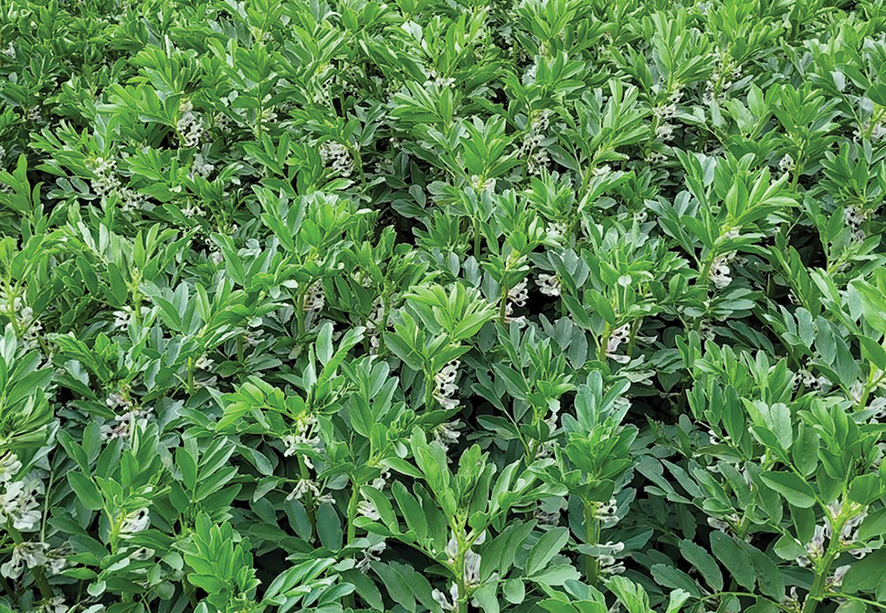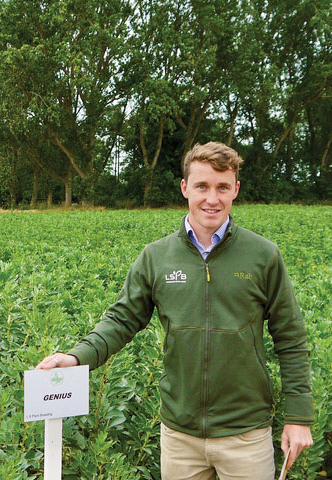An impressive 11 varieties join the 2024 PGRO Descriptive List
15th December 2023
A total of six combining peas, two winter beans and three spring beans have completed the requisite number of years in trials and demonstrated the necessary qualities for inclusion in the PGRO Descriptive List for pulses. Rachel Hicks reports.

PGRO senior technical officer Dr Chris Judge launched the 2024 Descriptive List in late November during a webinar attended by almost 100 farmers, breeders, agronomists and industry stakeholders.
He explained that despite going through heatwaves, cold snaps and a wide variety of temperatures and conditions, trials were conducted successfully and the varieties grown across the country demonstrated good consistency in terms of yield and impressive disease resistance.
“The control yield for peas, spring beans and winter beans were all very similar to the 2023 Descriptive List,” Chris said. “Looking at the five years currently used in the datasets, yields were slightly down in 2023 compared to 2022 for all three pulse groups.”
Two yellow combining peas – Concerto (LSPB) and Batist (Senova) – are the new top-yielding varieties producing 115% and 113% of the control respectively. KWS Flam is the other new yellow pea, yielding 110%.
A new pink pea category has been created for the Descriptive List to accommodate the new variety Flamingo (Cope Seeds & Grain). In trials it was the lowest-yielding pea listed (78%).
Shazam (Senova) and Reacher (IAR Agri) are the two green peas making their debut on the list, and both have good all-round qualities in terms of yield and disease resistance.
Elsoms Seeds is the UK agent for a new marrowfat variety, Vision, which has become the highest yielder in that category, achieving 100% of the control.
In 2023 many winter bean trials struggled with frost damage after two cold snaps in short succession last winter. Despite this, harvest conditions were good in the summer and two new varieties – LG Arctic (Limagrain) and Ninja (Senova) – have completed their ascent to the Descriptive List.
Conversely, spring bean trials suffered in the heat. The hotter-than-average June led to similar yields to 2022 when heatwaves also struck during key stages of crop development. Synergy (Saaten Union) is the highest yielding of the three varieties entering the list for 2024 (107%), closely followed by Navara (Senova) which yielded 106%, and LG Hawk (Limagrain) which returned 101%.
The full Descriptive List data can be downloaded from www.pgro.org.

Strong and consistent performance
The new PGRO Descriptive Lists for spring beans and combining peas are once again headed by LSPB varieties, confirming the strong and consistent performance of the company’s varieties, both in official trials and on farm.
“The 2024 DL for spring beans includes six LSPB varieties, giving pulse growers a wide choice to suit all farm conditions and rotations,” comments LSPB pulses product manager, Michael Shuldham.
“Genius is at the top of the DL with the highest seed yield and offers growers a large sized bean plus excellent agronomic characters including high standing ability at harvest and good resistance to downy mildew.
“Lynx is a consistently high yielding variety that brings reliability in changing seasons with a very high seed yield, good resistance to downy mildew and high standing ability at harvest.
“Both have yields significantly above varieties introduced just a few years ago to underline the growth in varietal yield performance – as well as improvements in agronomic characteristics.
“The other feature to note is that LSPB now has the LVC varieties (low vicine/convicine) Futura and Victus on the DL with yields within a few per cent of the leading traditional varieties. The improved nutritional profile of these will help to widen the market for spring beans – we see LVC as the future of spring beans in the UK.”
It is worth stressing that yield alone is not everything, and agronomic characters and quality can be equally important. As one example for spring beans, Yukon’s lower yield on the DL is offset by its highest downy mildew resistance rating plus the earliest maturity on the spring bean DL, added to a very bold sample to increase its market potential. Grower experiences have shown it is around 14 days earlier than most spring beans in practical farm situations – indeed Yukon’s earliness over other varieties may have had an adverse influence on its yield figures in official trials.
The 2024 DL for combining peas shows a similar presence from LSPB, with Concerto leading the yellow pea DL. Concerto is a new addition to the List and brings a massive yield advantage back to yellow peas with a very good standing power at harvest and offers a good option to growers looking to get peas into their rotation. Orchestra is the other high yielding LSPB yellow pea on the DL.
The green pea DL is headed by Carrington – the highest yielding variety with high downy mildew resistance and good standing power, plus three further high yielding LSPB green peas; Butterfly, Stroma and Bluetime.
In the marrowfat section, Takayama and Akooma are both high-yielding varieties with good resistance to downy mildew and good standing ability at harvest.
Michael concludes: “In summary, LSPB’s pulse varieties are a strong constituent of the new PGRO 2024 Descriptive Lists and show the continuing improvement of pulses for yield, agronomic characters and marketability, underlining our commitment to developing the UK pulse crop to the benefit of growers and end users in the future.”

High yielding marrowfat variety continues to impress
Two of the UK’s pulse specialists – Wherry & Sons Limited and Robin Appel Limited – both predict that leading marrowfat variety Octavia will increase market share and growing area over the next two years, providing current seed stock levels and seed availability increase in line with current demand. The variety, bred by Nordic Seeds and marketed in the UK by breeder Elsoms Seeds, has already established a strong position as the highest yielding, commercially available marrowfat variety on the current PGRO Descriptive List and looks a solid choice for pulse growers according to Wherry & Sons associate director, Franek Smith.
Franek comments: “As the highest-yielding available marrowfat variety, and with a 7 for standing ability at harvest, Octavia has already caught the eye of many pulse growers. It’s well-liked on-farm with a reputation for achieving high yields and is certainly a step forward from Sakura, formerly the leading marrowfat pea since 2008. It has not yet reached its full market potential and I believe grower demand is certainly there. At Wherry’s, we’ve sold out of Octavia for 2024 and already have significant interest for 2025.
“I first saw Octavia in trials in 2019 where it performed extremely well. I think its introduction to the market came at the right time, offering growers greater varietal choice with improved standing ability being a critical factor. Key end markets for Octavia, including both wasabi peas and allergy-free pea-based crisps that are significantly higher in fibre and protein than traditional potato crisps, should help keep future demand high alongside the agronomic benefits that pulses bring to all rotations.
“Although most growers understand that pulses are nitrogen fixing, and make an excellent entry for a first wheat, I think it’s also very important to remember that they are a carbon negative crop, offsetting more carbon than they require. With future payment incentives in contracts for reduced carbon, I firmly believe that more growers should introduce pulses into their rotation as a key way of achieving new green targets,” he concludes.
Pulse trader and marrowfat specialist, Andrew Brown, of Robin Appel Limited supports Franek’s comments, and – as a former pulse grower himself – sees Octavia’s key agronomic trait of standing ability at harvest as the one of the keys to its future success.
Andrew adds: “Historically, marrowfat peas always had a reputation of being more difficult to grow due to their weaker straw. However, I believe Octavia has helped to change that negative perception with its ability to stand so well at harvest and go through the combine more smoothly than its predecessors. Ease of combining, so that more of the crop goes into the shed creating high yields and better overall crop quality, is absolutely critical to growers.
“The greater carbon efficiency of pulses, due to the residual nitrogen they leave in the soil for the following crop, make them an increasingly attractive option for growers who need to reduce their carbon audits. On end markets, the known health benefits of marrowfat peas and established markets for plant-based protein in Asia should offer a strong future for varieties such as Octavia.
“I can certainly see Octavia taking more market share and securing a larger growing area over the next 2–3 years, providing there’s an increase in future seed stocks of the variety to ensure greater seed availability.”
Read more arable news here.
